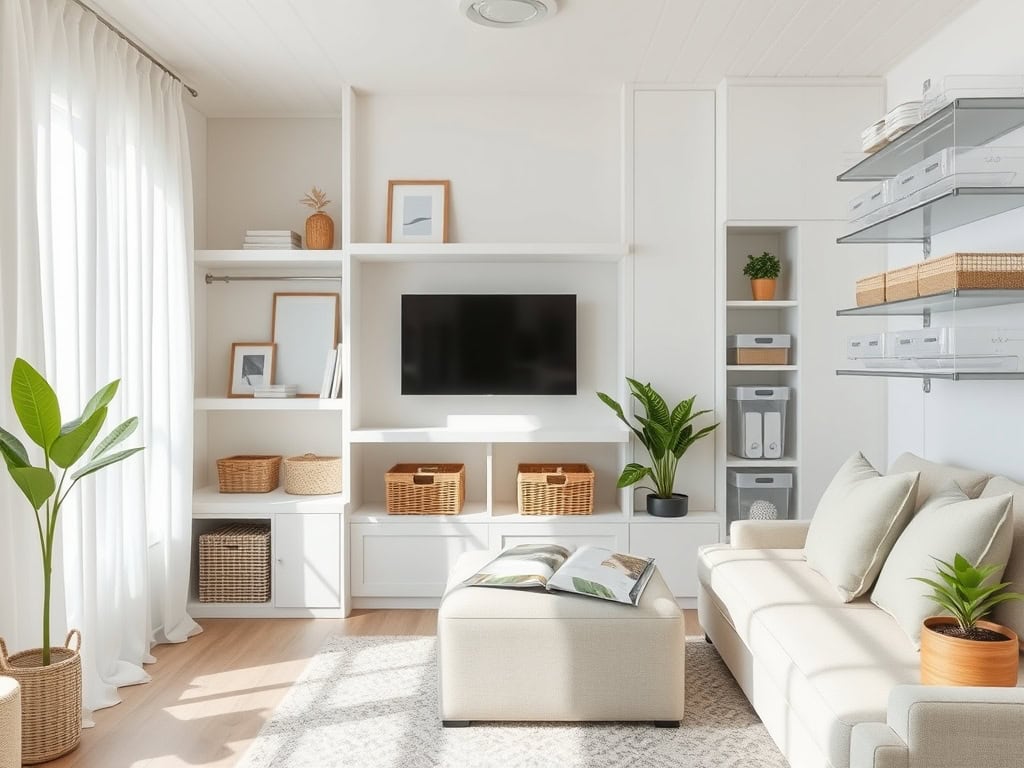Living in a mobile home doesn’t mean you have to compromise on style or organization! As someone who’s mastered the art of small-space living, I’ll share my favorite storage tricks that’ll transform your cozy home into a clutter-free haven. You’d be amazed at how much space you actually have – it’s just waiting to be discovered. From clever furniture choices to innovative vertical solutions, these proven tips will help you create a space that’s both functional and fabulous.
Maximize Vertical Space With Wall-Mounted Storage Solutions
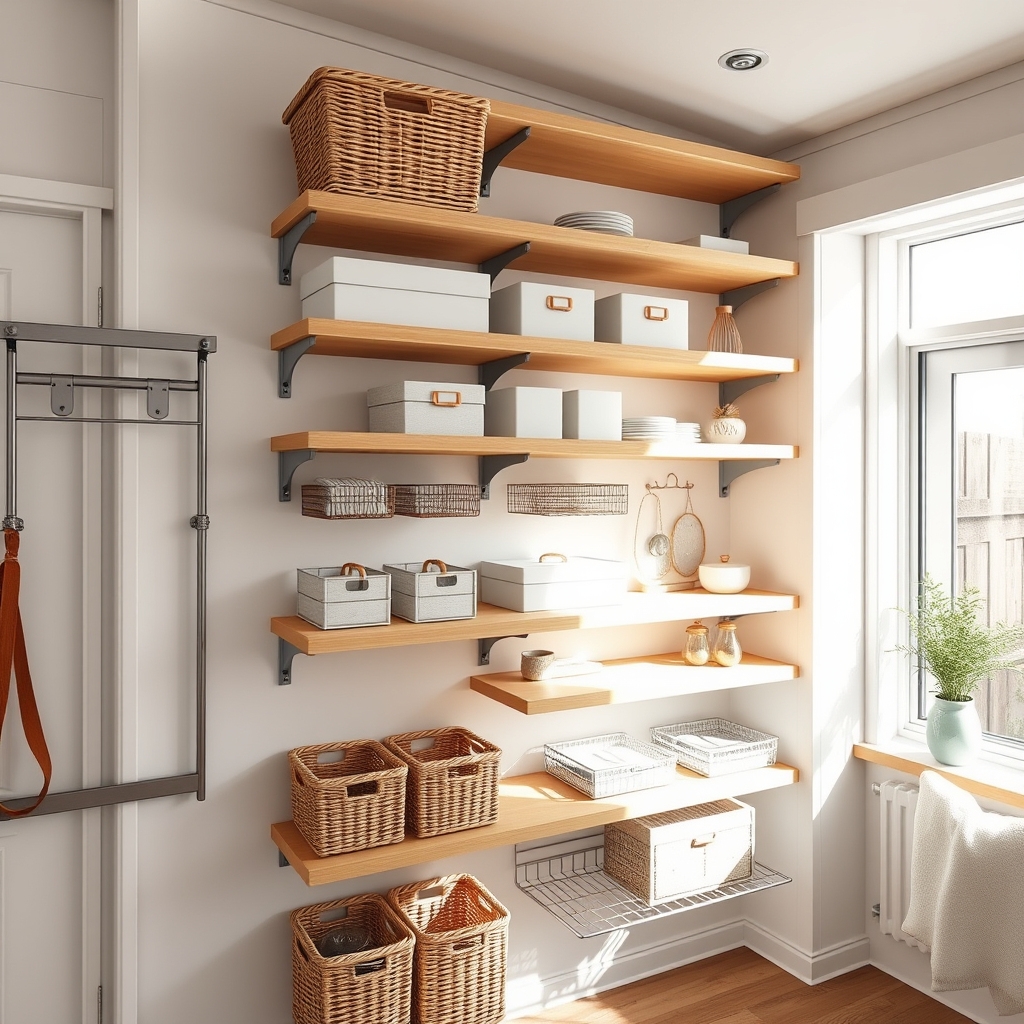
Making the most of vertical space in a mobile home is crucial for creating an organized and spacious living environment. Wall-mounted storage solutions offer a practical way to utilize otherwise unused wall space while keeping floors clear and maintaining a clutter-free atmosphere.
In mobile homes where square footage is limited, vertical storage becomes a game-changer for organization and accessibility. Wall-mounted solutions can transform any room from cramped to efficient, creating designated spaces for everything from kitchen essentials to personal belongings.
Required Items:
- Stud finder
- Level
- Drill and drill bits
- Screwdriver
- Wall anchors
- Mounting brackets
- Measuring tape
- Pencil
- Wall-mounted shelving units
- Storage hooks
- Floating shelves
- Wire baskets or organizers
- Command strips (for lightweight items)
Start by mapping out your wall space using a measuring tape and pencil, marking the locations where you plan to install storage solutions. Use a stud finder to locate wall studs, as these provide the most secure mounting points for heavier items.
Install mounting brackets and shelving units at varying heights to create a dynamic storage system that accommodates items of different sizes. When mounting wire baskets or organizational units, ensure they’re positioned at easily accessible heights for frequent use.
For areas without studs, use appropriate wall anchors rated for the weight of your storage items. Install floating shelves in strategic locations, such as above doorways or in narrow wall spaces, to maximize every available inch.
Consider creating zones for different types of items – higher shelves for seasonal or less-frequently used items, and eye-level storage for everyday essentials.
Additional Tips: Incorporate adjustable storage solutions whenever possible to allow for flexibility as your storage needs change. Use clear containers on shelves to easily identify contents, and label everything systematically.
Regularly assess the functionality of your vertical storage system and make adjustments as needed to maintain optimal organization and accessibility.
Choose Multi-Purpose Furniture That Works Double Duty
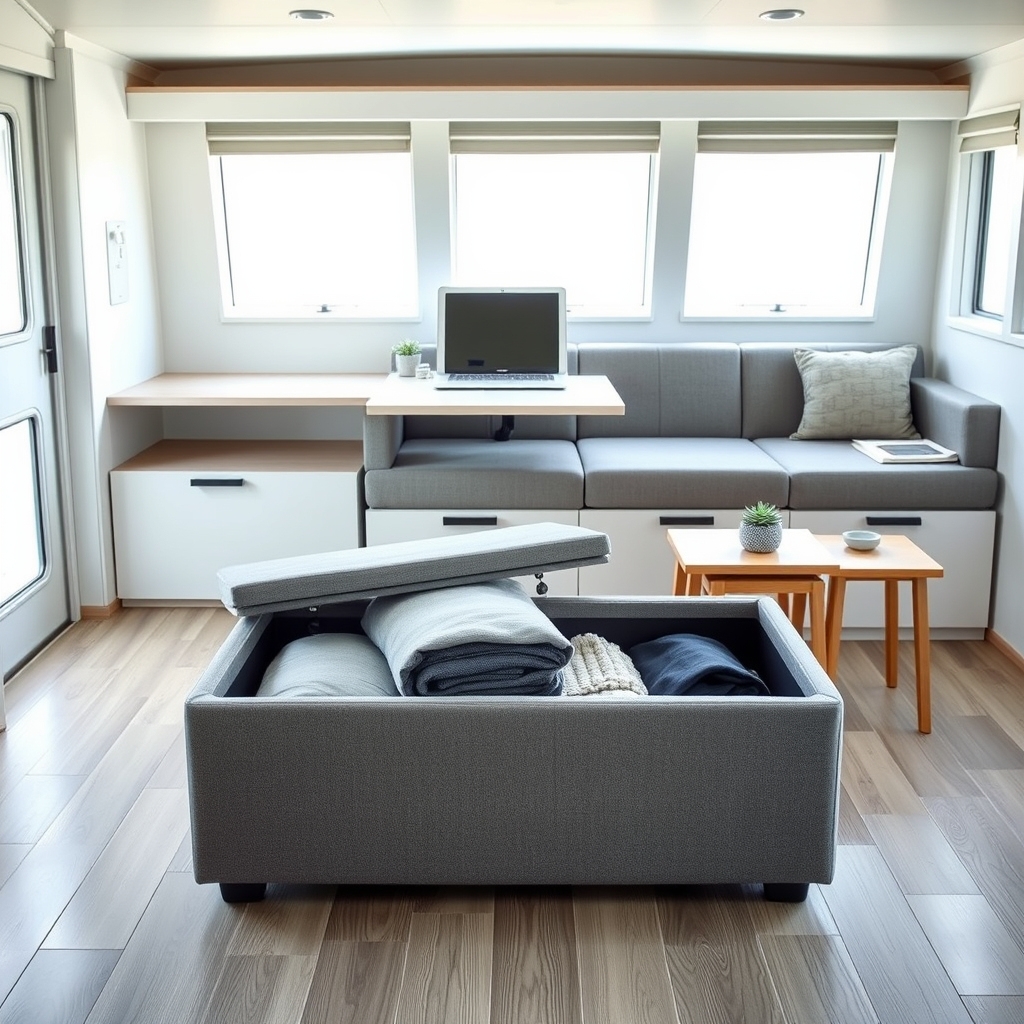
Living in a mobile home requires careful consideration of every square inch of space. Multi-purpose furniture serves as a strategic solution to maximize limited areas while maintaining functionality and style. These versatile pieces not only reduce clutter but also create a more organized and efficient living environment.
Selecting furniture that performs multiple functions is particularly crucial in mobile homes where space comes at a premium. Storage ottomans, fold-down tables, and convertible sofas can dramatically increase your storage capacity while maintaining the comfort and aesthetic appeal of your home.
Required Items:
- Measuring tape
- Floor plan or layout sketch
- Storage ottomans
- Convertible sofa bed
- Fold-down tables
- Storage bench seating
- Nesting tables
- Bed with built-in storage
- Multi-tier side tables
- Wall-mounted furniture
Start by assessing your space and measuring key areas where multi-purpose furniture could be implemented. Focus on high-traffic zones and identify furniture pieces that can be replaced with dual-function alternatives.
Replace traditional coffee tables with storage ottomans that can hold blankets, magazines, or games while serving as extra seating. Install murphy beds or platform beds with built-in drawers to maximize bedroom space.
Consider vertical space by incorporating wall-mounted desks that fold away when not in use, or installing floating shelves that can serve as both storage and display areas. In dining areas, opt for expandable tables with hidden storage compartments or bench seating that lifts to reveal additional storage space.
Select nesting tables that can be separated when needed for entertaining but stack together to save space during daily use.
Additional Tips:
When selecting multi-purpose furniture, prioritize pieces that offer the storage solutions you need most. Choose items with smooth-operating mechanisms and sturdy construction to ensure longevity.
Remember to maintain clear pathways and avoid overcrowding spaces, as this can negate the benefits of your space-saving furniture. Regularly evaluate the effectiveness of your furniture choices and be willing to make adjustments as your storage needs change.
Install Space-Saving Door and Cabinet Organizers
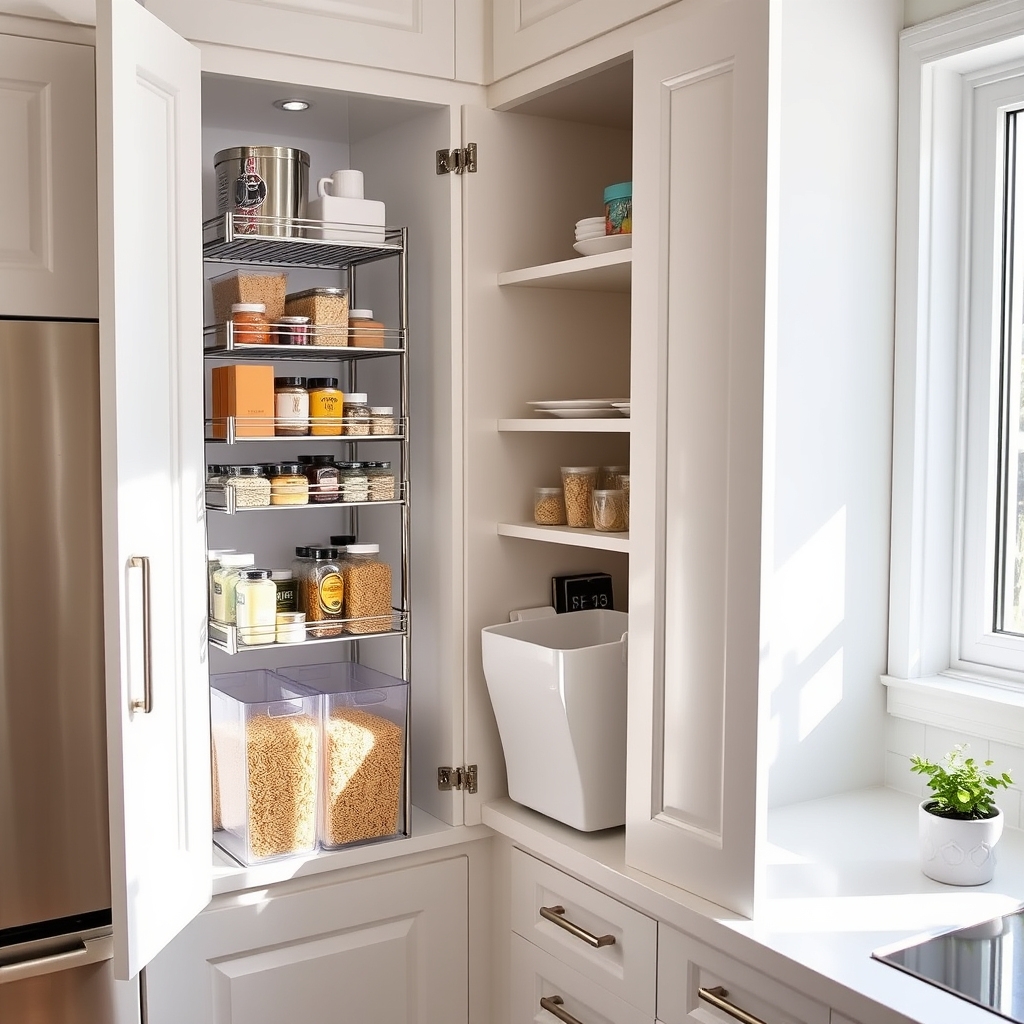
Living in a mobile home requires maximizing every inch of available space, and doors and cabinets present excellent opportunities for additional storage solutions. These often-overlooked vertical surfaces can be transformed into efficient organizing zones that help declutter countertops, floors, and other surfaces throughout your home.
Installing door and cabinet organizers is a cost-effective way to multiply your storage capacity without sacrificing precious floor space. These organizational tools can accommodate everything from cleaning supplies and toiletries to pantry items and clothing accessories, making them invaluable additions to any mobile home.
Required Items:
- Over-the-door hanging organizers
- Command hooks or mounting hardware
- Cabinet door hanging baskets
- Tension rods
- Measuring tape
- Screwdriver
- Level
- Drill (if needed)
- Door-mounted spice racks
- Cabinet door mounted trash bin
- Adhesive door-mounted hooks
Begin by measuring your doors and cabinet spaces to ensure proper fit of organizing tools. Install over-the-door organizers first, making sure they don’t interfere with door closure.
For cabinet doors, mount organizational tools at appropriate heights that allow easy access while maintaining clearance for shelves and other items inside. When installing hardware, use appropriate mounting methods – command strips for lightweight items and secure screws for heavier organizers.
For optimal use of cabinet door space, consider installing tiered organizers that maximize vertical storage. Position frequently used items at eye level and lesser-used items lower down. Ensure all mounted items are secured properly and test door closure several times to prevent any interference with existing cabinet contents or door function.
Additional Tips: Regularly assess the weight capacity of your organizers and avoid overloading them. Consider using clear organizers to easily locate items, and label sections for better organization.
Periodically check mounting hardware and tighten as needed to prevent loosening over time. Remember to measure the depth of your cabinets and doors to ensure organizers won’t prevent proper closure or damage door hinges.
Create Custom Storage Under Windows and in Corners
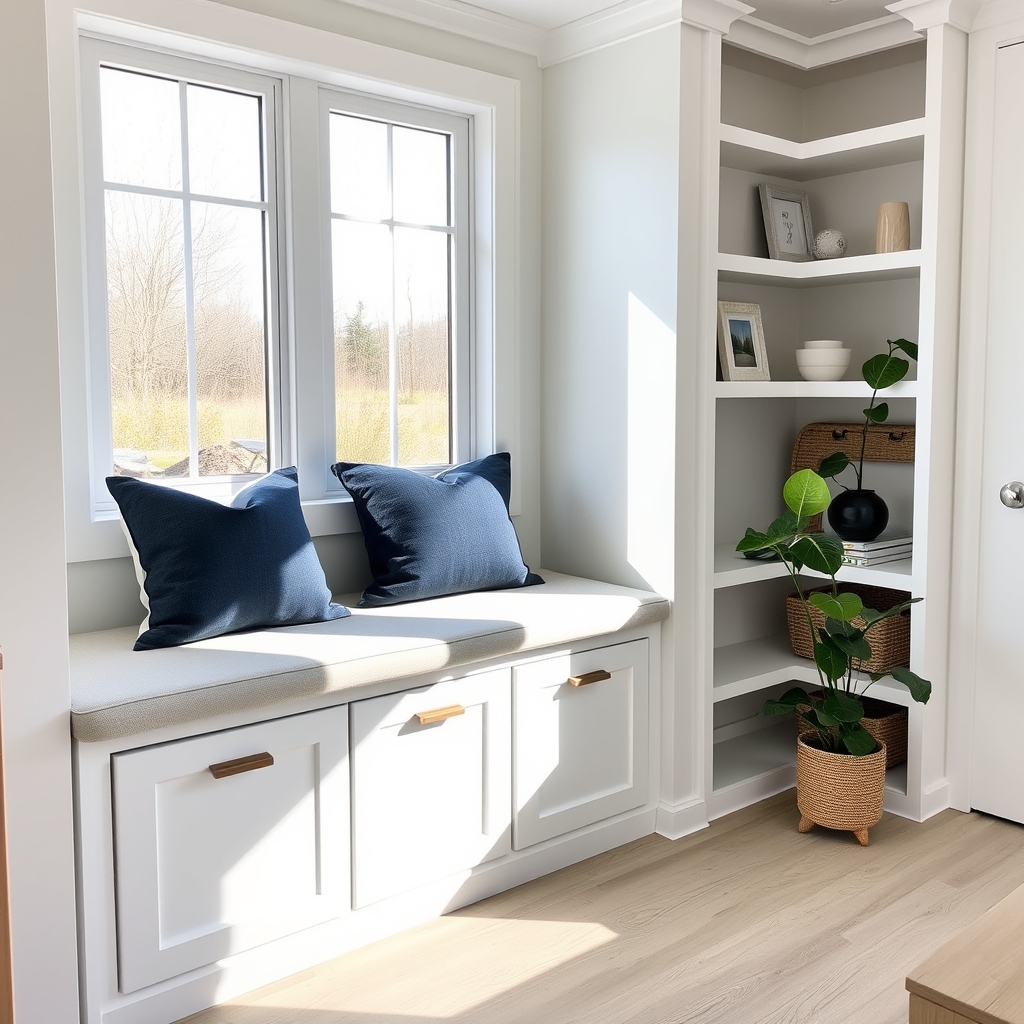
Making the most of every square inch in a mobile home is crucial for comfortable living, and the spaces under windows and in corners often represent untapped storage potential. These traditionally underutilized areas can be transformed into functional storage spaces that blend seamlessly with your home’s aesthetic while providing valuable storage solutions.
Custom storage in these areas not only maximizes space efficiency but also adds character to your mobile home. Window seats with built-in storage and corner units can serve multiple purposes, offering both practical storage and additional seating or display areas, making them invaluable additions to any mobile home.
Required Items:
- Measuring tape
- Level
- Power drill
- Screwdriver
- Wood panels or pre-made storage units
- Hinges
- Handles
- Screws and anchors
- Wood glue
- Sandpaper
- Paint or finish
- Safety equipment (goggles, gloves)
Start by measuring the available space under windows and in corners precisely, accounting for any heating vents or electrical outlets. For under-window storage, construct or install bench-style storage units that fit snugly in the space, incorporating hinged tops for easy access.
Corner spaces can be maximized with diagonal cabinets or stepped shelving units that follow the angular space naturally. When installing under-window storage, ensure proper support by securing the unit to wall studs.
For corner storage, utilize triangle-shaped shelves or graduated storage cubes that maximize the awkward angle while maintaining accessibility. Paint or finish the units to match your existing décor for a cohesive look.
Consider incorporating adjustable shelving systems within your custom storage to accommodate items of varying sizes. Use clear containers or baskets to organize smaller items, and label everything clearly.
Remember to leave adequate ventilation space if storing items near windows to prevent moisture damage, and ensure any window treatments can still function properly with your new storage solutions in place.
Utilize Hidden Storage Opportunities in Furniture and Floors
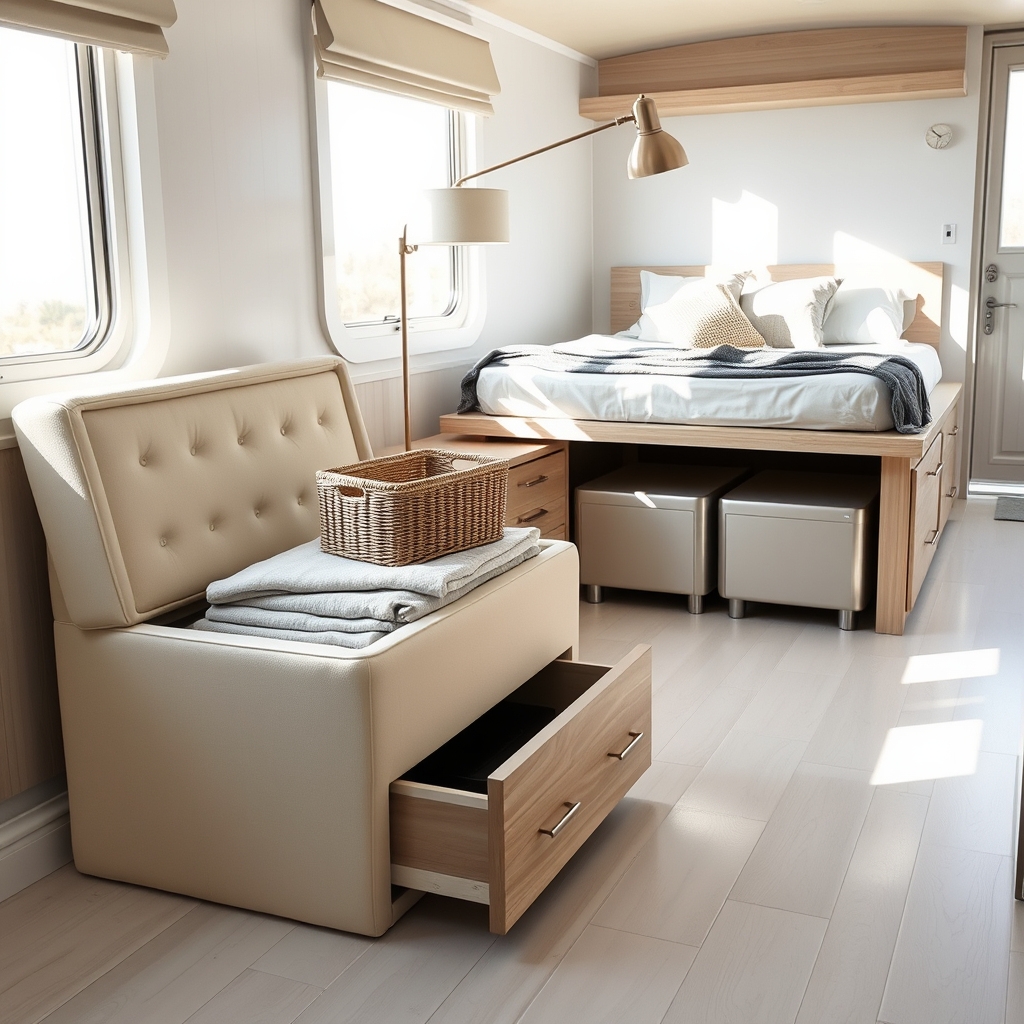
Living in a mobile home requires creative thinking when it comes to storage solutions. Every square inch counts, and traditional storage methods may not always be sufficient for your needs. Hidden storage opportunities in furniture and floors represent an often-overlooked goldmine of extra space that can dramatically increase your storage capacity without cluttering your living area.
Making use of hidden storage spaces not only helps keep your mobile home organized but also maintains its aesthetic appeal. By incorporating storage solutions into existing furniture and utilizing dead space beneath floors, you can effectively double your storage capacity while maintaining a clean, minimalist look that makes your mobile home feel spacious and welcoming.
Required Items:
- Measuring tape
- Storage containers
- Under-bed risers
- Hollow ottoman or storage bench
- Floor storage containers
- Drawer organizers
- Furniture with built-in storage
- Labels
- Basic tools (screwdriver, drill)
- Storage bags
Start by conducting a thorough assessment of your furniture pieces and floor space. Identify furniture items that could be replaced with storage-equipped alternatives, such as beds with drawers underneath, coffee tables with compartments, or hollow ottomans.
Install bed risers to create additional under-bed storage space, and use vacuum-sealed bags to maximize this area.
For floor storage, locate areas where removable panels could be installed or existing access points could be utilized. Consider installing trap doors in less-trafficked areas of your mobile home, ensuring they’re properly reinforced and weather-sealed.
Use waterproof containers in these spaces to protect stored items from moisture.
Transform existing furniture by adding organizational elements like drawer dividers, hanging organizers, or pull-out bins. Look for opportunities to modify furniture pieces to incorporate hidden compartments, such as adding secret drawers to existing tables or creating storage space in window seats.
Additional Tips: Regularly rotate stored items based on seasonal needs, and maintain an inventory list of items stored in hidden spaces to avoid forgetting about them.
Use clear containers when possible to easily identify contents, and consider installing motion-sensor lights in floor storage areas for better visibility.
Always ensure that hidden storage solutions don’t compromise the structural integrity of your mobile home or create safety hazards.
Design Smart Closet Systems for Maximum Efficiency
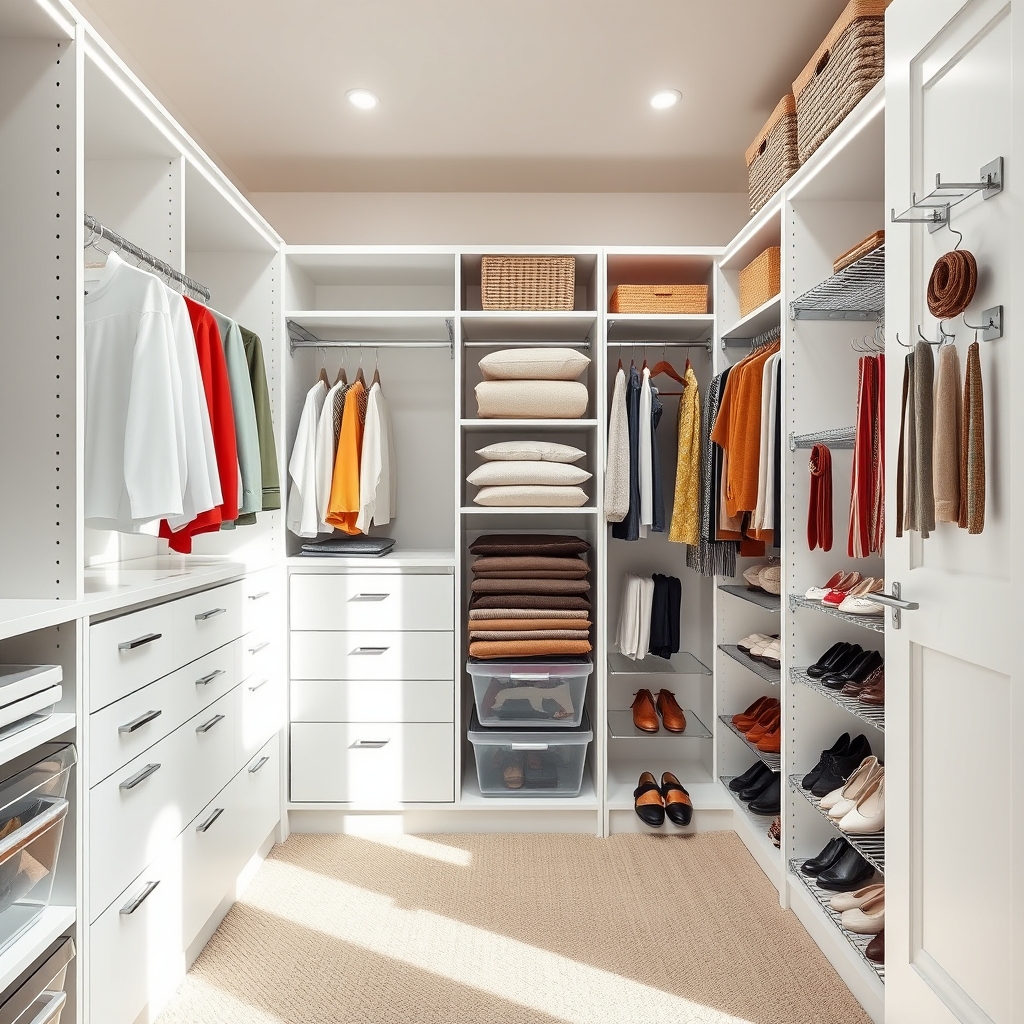
Efficient closet organization is crucial in mobile homes where every square inch counts. A well-designed closet system can double or even triple your usable storage space while maintaining easy access to all your belongings. Smart closet systems not only help eliminate clutter but also create a more streamlined and stress-free living environment.
Mobile homes present unique challenges when it comes to closet space, often featuring smaller dimensions and unusual configurations. By implementing a systematic approach to closet organization, you can transform these compact spaces into highly functional storage areas that work for your specific needs and lifestyle.
Required Items:
- Measuring tape
- Closet rod
- Adjustable shelving units
- Storage bins and baskets
- Drawer organizers
- Over-the-door hooks
- Space-saving hangers
- Label maker
- Storage boxes
- Wall-mounted organizers
- Shoe racks
- Tension rods
Start by completely emptying the closet and taking precise measurements of the space, including height, width, and depth. Create distinct zones within the closet based on your specific needs – designate areas for hanging clothes, folded items, shoes, and accessories.
Install adjustable shelving units and rods at various heights to maximize vertical space utilization. Implement a double-rod hanging system where appropriate, with longer items like dresses and coats on the top rod and shorter items like shirts and pants on the bottom.
Utilize the back of the closet door with over-the-door organizers for additional storage of accessories, shoes, or cleaning supplies. Install pull-out bins or baskets for smaller items and consider adding drawer units for folded clothing if space permits.
For optimal organization success, conduct regular maintenance of your closet system by purging unused items every season and maintaining the designated zones. Use space-saving hangers consistently, and implement a one-in-one-out rule to prevent overcrowding.
Consider installing motion-sensor lights or battery-operated LED strips to improve visibility and accessibility in these typically darker spaces.
Implement Rolling Storage Solutions for Flexibility
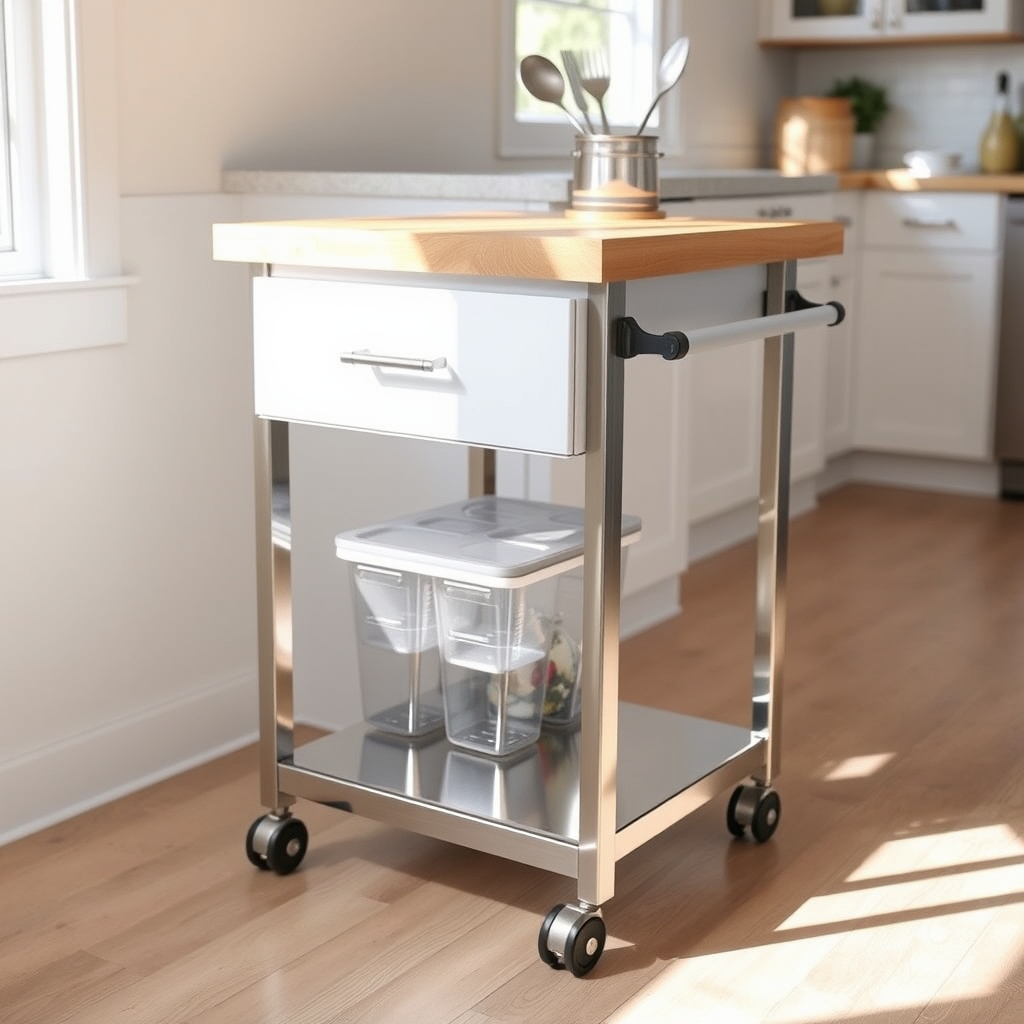
Rolling storage solutions are essential in mobile homes where space is at a premium and needs can change frequently. These versatile units allow residents to quickly reconfigure their space, access items from multiple angles, and maximize every square inch of available storage area.
The mobility factor of rolling storage units creates dynamic spaces that adapt to different situations, whether hosting guests, working from home, or simply accessing seasonal items. These solutions are particularly valuable in mobile homes where permanent built-ins might be impractical or restrict future layout changes.
Required Items:
- Wheeled storage carts
- Rolling kitchen islands
- Caster wheels
- Storage bins or baskets
- Measuring tape
- Labels
- Drawer organizers
- Tool set for assembly
- Level
- Rubber stoppers or wheel locks
Start by measuring your available spaces and traffic patterns to determine appropriate sizes for rolling units. Choose storage solutions that can serve multiple purposes – such as a rolling kitchen island that provides both storage and extra counter space.
Ensure all wheels are appropriate for your flooring type and include locking mechanisms for stability when parked. Install rubber stoppers or sliding tracks along walls where rolling units will be stored to prevent damage and maintain proper positioning.
Organize items within the rolling storage units by frequency of use, with most-used items at easily accessible heights. Group similar items together and use clear containers or labels to maintain organization.
Position rolling units initially in their primary locations but test different arrangements to find optimal placements. Remember to keep pathways clear and maintain proper weight distribution within mobile home guidelines.
Additional Tip: Consider installing small handles or pulls on both sides of rolling units to make them easier to maneuver, and regularly maintain the wheels and locking mechanisms to ensure smooth operation. Keep weight distribution in mind when loading items, placing heavier objects at the bottom to prevent tipping.
Transform Dead Space Into Functional Storage Areas
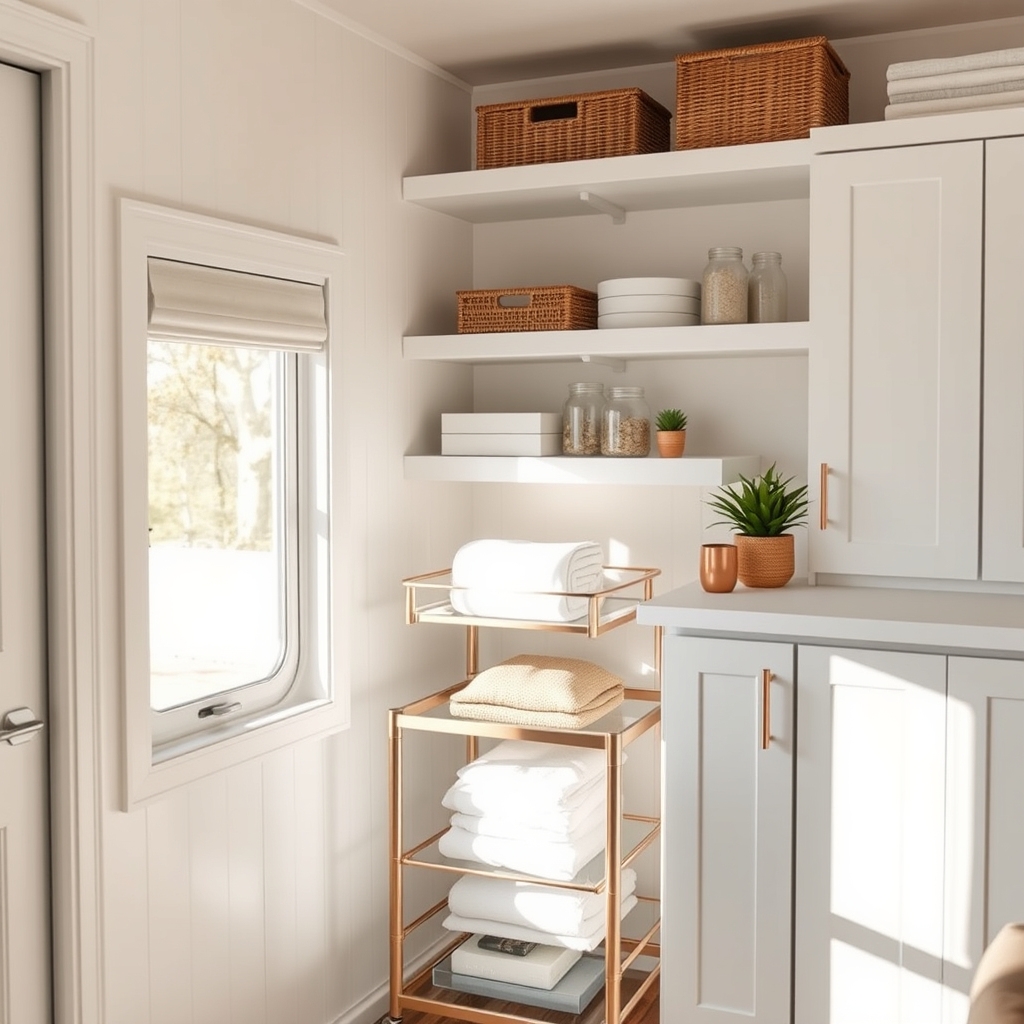
Living in a mobile home requires creative thinking when it comes to storage solutions. Every square inch counts, and those seemingly useless spaces – from awkward corners to unused vertical areas – hold untapped potential for organizing your belongings. Transforming dead space into functional storage not only maximizes your living area but also helps maintain a clutter-free environment.
Dead space transformation can revolutionize how you use your mobile home, creating storage opportunities in areas you might’ve overlooked. These spaces include areas under furniture, gaps between appliances, unused wall sections, and even the backs of doors. With proper planning and organization, these overlooked spaces can become valuable storage solutions.
Required Items:
- Measuring tape
- Level
- Pencil and paper
- Wall anchors
- Screwdriver
- Drill
- Over-door organizers
- Floating shelves
- Storage bins
- Command hooks
- Tension rods
- Under-bed storage containers
- Corner shelf units
Start by conducting a thorough assessment of your mobile home’s dead spaces. Measure each potential storage area carefully, noting dimensions and any obstacles like electrical outlets or vents. Focus on vertical spaces first, as these are often the most underutilized. Install floating shelves in empty wall spaces, particularly in bathrooms, kitchens, and bedrooms.
Next, tackle the horizontal dead spaces. Utilize the area under beds with rolling storage containers, and install shelf units in awkward corners. Add over-door organizers to maximize door space in bedrooms and bathrooms. For spaces between appliances or furniture, consider installing narrow rolling carts that can be easily accessed when needed.
Look for opportunities to create multi-functional spaces. Install tension rods in cabinet dead spaces for cleaning supplies, use command hooks on the sides of cabinets for hanging items, and add shelf risers to maximize vertical space within cabinets and closets.
For optimal results, maintain a consistent organization system and regularly assess the functionality of your storage solutions. Label containers clearly, keep frequently used items easily accessible, and periodically review stored items to prevent accumulation of unnecessary belongings.
Consider using clear storage containers in hidden spaces to easily identify contents without having to pull everything out.
Organize With Attractive Baskets and Decorative Containers
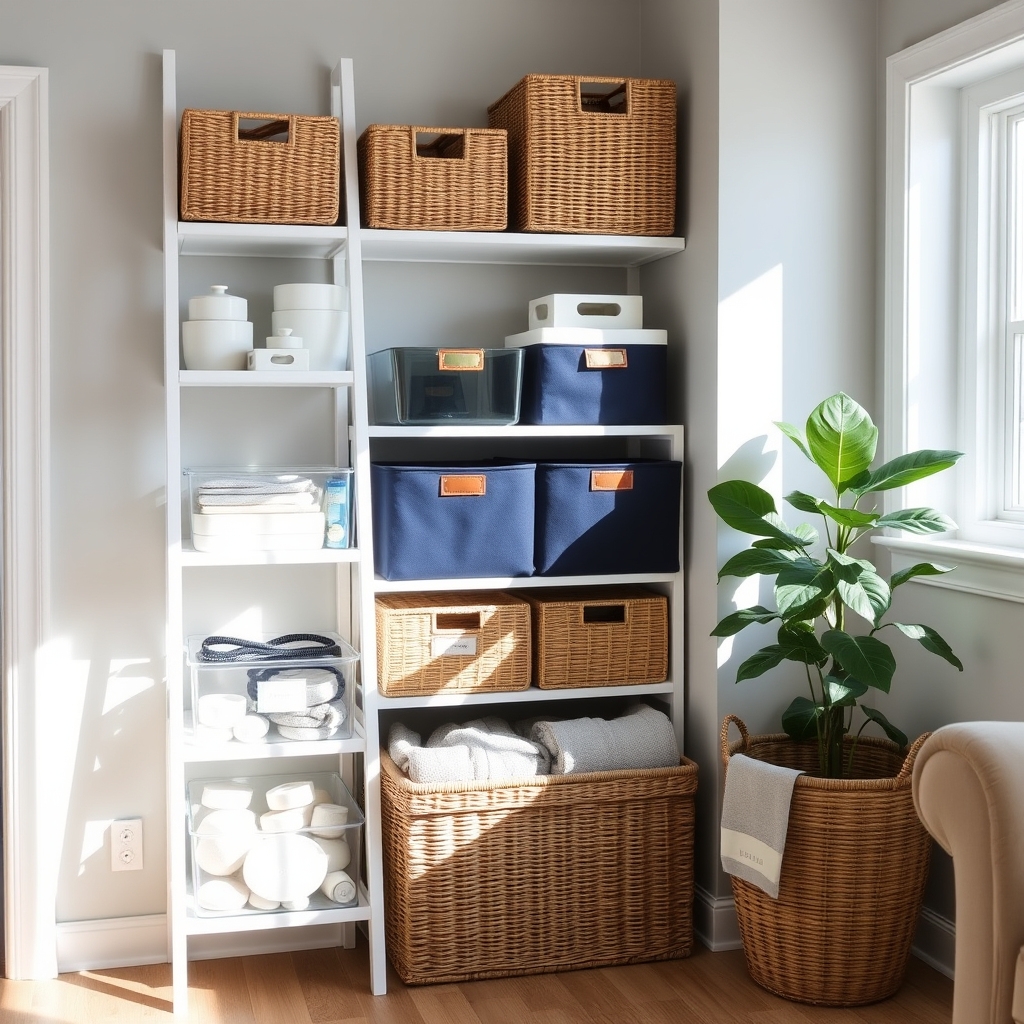
Decorative storage containers and baskets serve as both functional organizers and aesthetic elements in a mobile home’s limited space. By incorporating attractive storage solutions, you can maintain order while enhancing your home’s visual appeal, effectively turning necessary storage into part of your decor.
The key to successful basket and container organization lies in selecting pieces that complement your existing decor while providing practical storage solutions. Coordinated containers create a cohesive look throughout your mobile home, reducing visual clutter and maximizing the functionality of your space.
Required Items:
- Variety of decorative baskets (woven, wire, fabric)
- Storage containers in different sizes
- Labels or label maker
- Measuring tape
- Container dividers
- Shelf liner
- Basket liners
- Storage bin organizers
- Clear containers for visibility
- Decorative boxes
Start by assessing your storage needs and measuring the spaces where baskets and containers will be placed. Choose containers that fit properly and match your color scheme or design theme. Group similar items together and assign specific containers for each category.
Place frequently used items in easily accessible containers, while seasonal or rarely used items can go in decorative boxes on higher shelves. Consider using clear containers for items you need to locate quickly, and opt for attractive baskets with lids for items that should be concealed.
Label each container clearly, either with a label maker or decorative tags, to maintain organization long-term. Layer your storage solutions by using smaller containers within larger baskets to maximize space and keep items better organized.
Additional Tips: Rotate your storage containers seasonally to keep your space fresh and organized. Use basket liners to protect delicate items and maintain the containers’ appearance.
Consider using stackable containers when possible to maximize vertical space, and regularly assess the contents of your containers to prevent accumulation of unnecessary items. Remember to leave some empty space in each container to accommodate new items and maintain easy access to stored belongings.
Add Built-In Shelving for Books and Display Items
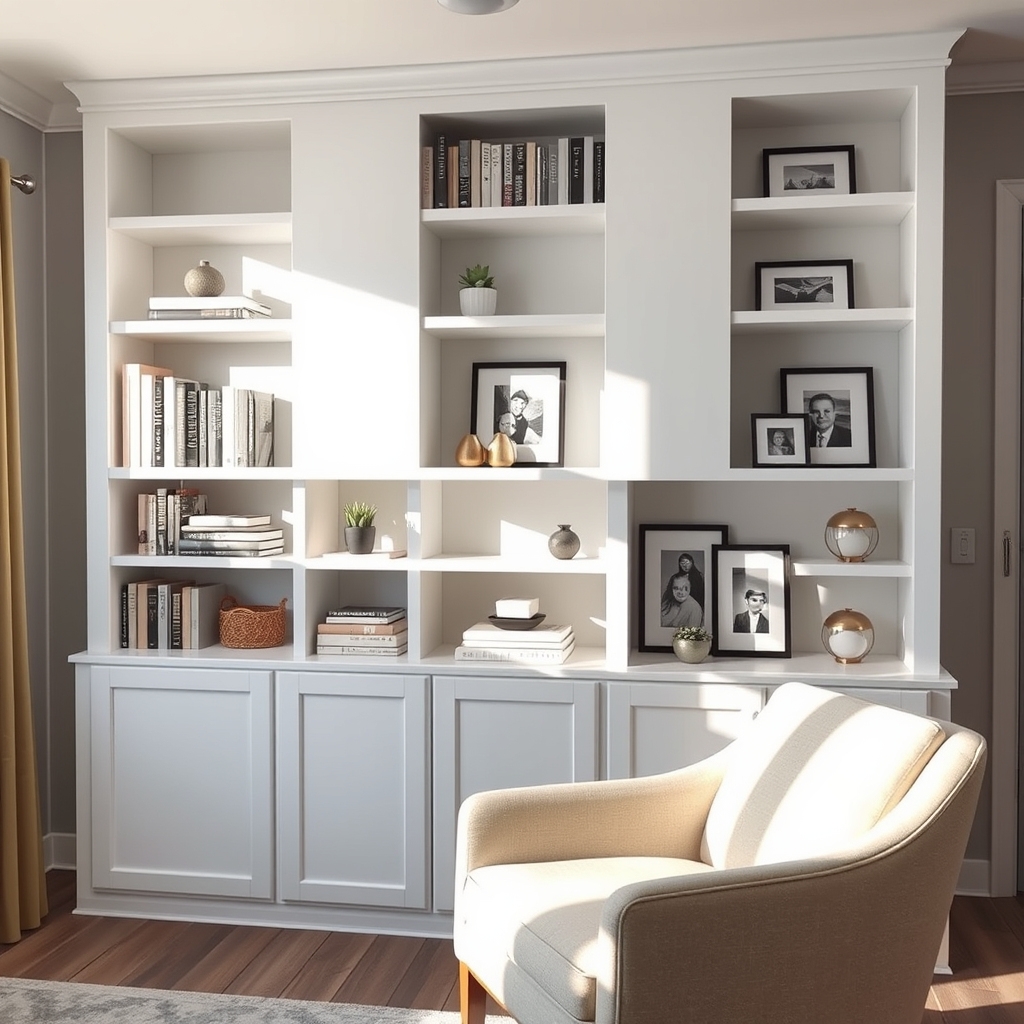
Built-in shelving transforms any mobile home wall into valuable storage space while creating an attractive focal point for displaying books, photos, and decorative items. Unlike freestanding bookcases that take up precious floor space, built-in shelving maximizes vertical storage potential and becomes a permanent design feature of your home.
Strategic placement of built-in shelving not only addresses storage needs but also adds character and personality to your living space. Whether installed in the living room, hallway, or bedroom, these custom storage solutions can be tailored to fit your specific space constraints and design preferences while maintaining the structural integrity of your mobile home walls.
Required Items:
- Measuring tape
- Level
- Stud finder
- Drill and drill bits
- Screwdriver
- Wall anchors
- Mounting brackets
- Shelf boards
- Wood screws
- Sandpaper
- Paint or finish
- Pencil
- Safety glasses
- Work gloves
Start by measuring your wall space and marking stud locations using a stud finder. Plan shelf spacing based on the height of items you’ll store, typically allowing 10-12 inches between shelves for books and 12-15 inches for larger display items.
Install mounting brackets directly into wall studs when possible, using appropriate wall anchors for additional support where needed. Cut shelf boards to size, sand edges smooth, and apply your chosen finish before mounting them securely to the brackets.
For the best visual impact and functionality, arrange books and display items thoughtfully once shelving is installed. Group similar items together, incorporate both horizontal and vertical stacking techniques, and leave some open space to prevent a cluttered appearance. Consider using bookends and small decorative boxes to keep items organized and create visual interest.
Additional Tips: Install adjustable shelf brackets to maintain flexibility as storage needs change. Incorporate LED strip lighting under shelves to highlight display items and add ambiance. Remember to distribute weight evenly across shelves and avoid overloading, particularly when using wall anchors rather than mounting directly into studs.
Regular dusting and occasional reorganization will keep your built-in shelving looking fresh and functional.

